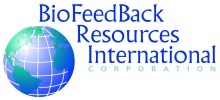

phone: 1-877-669-6463 ..... 914-762-4646
 |
 |
22 August 2012
- a BioFeedBack Resources International email newsletter -
written & edited by Harry L. Campbell, President
technical editing and production by Edwin Johnson
A free email service that keeps you posted on new information and products which increase the effectiveness of the services you offer, the economic health of your practice, and your creative thinking.

Podbean Blog for August 22, 2012
People don't get stressed all at once. It usually happens over a period of time. According to the Centers for Disease Control as much as 75%-90% of doctor visits are stress related. Many of the illnesses that are caused by stress are the results of the long-term reactions the body has to stress. As adults we have been dealing with stress for a long time. Most people probably have not learned effective stress management earlier in life. Wouldn't it be better if people were taught stress management as children or young adults? This could help minimize some of the stress related illnesses that might normally develop later in life like hypertension, diabetes, tension headaches, digestive problems, neck pain, back pain and more.
After more than a year of thinking and talking about it I finally started an after-school biofeedback program for students of my local high school - Ossining High School. This is the school that I graduated from in 1984. That was also the place I originally met Adam Crane who introduced me to biofeedback. He came to the school and demonstrated biofeedback to my class. I was instantly interested in this amazing technology that was able to detect and give feedback on responses the body has to what we are thinking. Along with my contact Martin McDonald at Ossining High School we selected a group of students who were interested in improving their grades.
We had a meeting with the students and their parents to describe the program that I was proposing to start. A small group decided to be part of the initial group to go through the program. The program starts with an intake and psychophysiological stress assessment including Surface EMG, Skin Temperature, Skin Conductance, Respiration, and Heart Rate/Blood Volume Pulse/Heart Rate Variability. This is followed by peripheral biofeedback training sessions including Surface EMG, Skin Temperature, Skin Conductance, Respiration, and Heart Rate/HRV. The next step is a series of baseline EEG recordings from CZ, C3, and C4 (Ten-20) scalp placements and a series of SMR EEG training sessions.
Once this is completed we will have group meetings to discuss ongoing stress management and attention training practice. Follow up booster sessions will also be scheduled.
My goals are to help the students improve their grades and as a side benefit decrease their chances of developing stress related disorders later in life.
So far the students are doing well with their training and are reporting that they believe that they are able to manage stressful situations better than before.
I have been approached by a few people who are having difficulty getting their BCIA certification experience requirements completed. The reasons usually are that they don't have equipment yet and or they don't have any clients that they can work on. I am opening up a few spots for opportunities to work on clients through this and other programs for people in this situation. I am supplying the clients, equipment, and supplies. Anyone who is interested can contact me. I look forward to reporting results from this program. I also plan to continue and expand the program to include a larger number of students in the future.
Harry@biofeedbackinternational.com
 Facebook: Biofeedback Resources International
Facebook: Biofeedback Resources International
 Twitter: Biofeedbackman
Twitter: Biofeedbackman
 Podbean
Podbean
914.762.4646 877-669-6463 fax:914.762.2281
****************************************************************